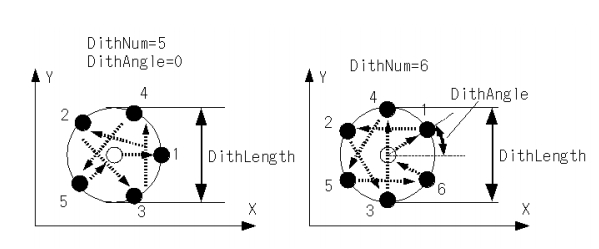Guide to MOIRCS Imaging Exposure Times
Background-Limited Operation
In order to achieve the maximum sensitivity for a given integration time, individual exposures should be long enough for the photon shot noise from the sky background to dominate the array read noise. In practice, background-limited performance (BLIP) should be achieved when the sky background noise exceeds the read noise (15 e-) by a factor of 3.
| Filter | Background(1) | Min. BLIP time (s) | Maximum Exposure(2) | |
|---|---|---|---|---|
| (mag/arcsec2) | e-/s/pixel | |||
| Y | 17. | 100 | 4.6 | 1200 |
| J | 15.5 | 460 | 2.1 | 261 |
| H | 14.0 | 2100 | 1.0 | 57 |
| Ks | 13.8 | 1310 | 1.3 | 92 |
Table 1: BLIP Operation
Note:
(1) The amplitude of the changes in the sky background level in near infrared is quite large. The change of the sky level by factor of 2-5 times (per night!) has ever been recorded. Values shown here are the approximate median during the 2009 - 2010 imaging observations.
(2) Note that the values here is based on the pure saturation. For reference, ~5% non-linearity level occurs around 35k ADU, roughly 60% of the saturation level (for ch1). We recommend to keep the sky level within 25000 ADU for science data. The typical unit exposure for faint objects would be 180-360 s for Y, 45-90 s for J, 10-30 s for H, 30-60 sec for Ks, respectively.
(3) See also the guideline for the choice of the NDR (multi-sampling) values for a BLIP operation which is described in the Multi-sampling Operation Page. Note that this is mostly for Y-band and the NB imaging observation.
Saturation Magnitudes
Saturation magnitude is extremely sensitive to the seeing. The example of saturation magnitude level under good seeing condition (~0.4'', when about 3% of the total flux from an unresolved source falls in the peak pixel) tabulated here is for old detector. We will update it soon.
For bright standard star observation we will take the data defocused.
| Filter | Saturation magnitude | ||||
|---|---|---|---|---|---|
| 1 s | 13 s | 21 s | 40 s | 120 s | |
| Y | 10.2 | 13.0 | 13.5 | 14.2 | 15.5 |
| J | 10.4 | 13.3 | 13.8 | 14.6 | 16.3 |
| H | 10.6 | 13.7 | 14.5 | 16.3 | - |
| Ks | 10.0 | 13.0 | 13.6 | 14.8 | - |
Table 2: Saturation Magnitude
(Note) This is for old detector! To be updated soon. Sorry for inconvenience.
Overhead
The overhead for new detectors installed 2016 is calculated as 12.5+NDR*1.5 (sec), where NDR is the number of multi-sampling (normal CDS is NDR=1). In addition, the time for telescope move is necessary. The time for telescope move would typically take 10-15 sec per dither for open tracking observation. For AG-tracking, the dither time will be much larger (20-60 sec, depending on the magnitude of the guide star).
In order to save time for telescope move, you can take more than one exposure at the same dither position by adding NEXPOSURE option. Telescope guiding is usually as good as ~0.2" rms for 2 to 3 minutes. If the seeing is good, shorter staying time per dither position would be beneficial for better psf.
Note: The old "COADD" option has been replaced to the "NEXPOSURE" option in 2016, according to the change of the detector readout system. COADD is no longer available.
A typical overheads under 9-point + center dither observation are shown in the table below. Values with specific condition can be calculated using the Overhead Calculator [Microsoft Excel Format].
| Filter | Overhead | Typical exposure time (s) |
|---|---|---|
| Y | 16 % | 165 s (NEXPOSURE=1) |
| J | 27 % | 75 s (NEXPOSURE=2) |
| H | 56 % | 30 s (NEXPOSURE=4) |
| Ks | 40 % | 45 s (NEXPOSURE=3) |
Table 3: Overheads
Note 1:
[Overhead] = ([Total Observing Time] - [Total Integration Time]) / [Total Integration Time]
Note 2:
Please note that the Subaru Imaging ETC DOES NOT calculate the entire overhead time since it depends on the number of exposures at each point of a dither pattern as well as dither size. Please use our Overhead Calculator for more exact values.
Dither Pattern
During the science data acquisition, a set of the imaging data is acquired with slightly shifting the position of the target (~10" to 20", depending on the maximum size of targets) between each exposure ("dithering"). This is for making the median-averaged sky image without objects ("median sky").
We use a circular pattern for dither for imaging observation, as shown below. Dither length (diameter of the circle) should be larger than the size of the largest object in the field, and the number of images by the dithered obs should be at least 5 for better median sky.

Figure 1
Old Page
The same information for OLD MOIRCS before 2016 can be found here. We keep this for record.
Please note that all data on these pages are subject to change as the evaluation of the performance of MOIRCS progresses.